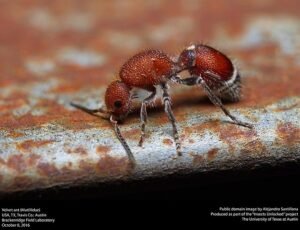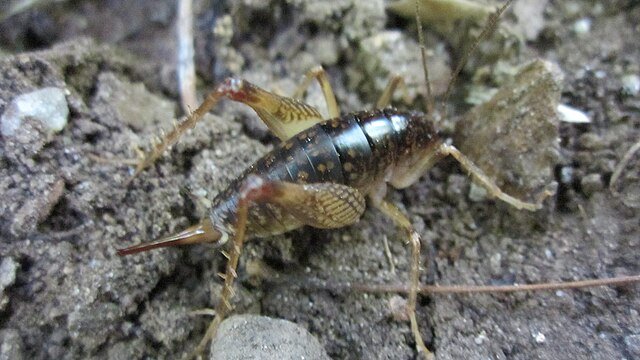Velvet Ants (Mutillidae): The “Cow Killers” of the Insect World
 Despite their name, velvet ants (family Mutillidae) are not true ants at all — they’re actually a type of solitary wasp. The females are wingless and covered with dense, colorful hairs that make them look like fuzzy ants. Their bright red, orange, or yellow coloration isn’t for decoration — it’s a warning.
Despite their name, velvet ants (family Mutillidae) are not true ants at all — they’re actually a type of solitary wasp. The females are wingless and covered with dense, colorful hairs that make them look like fuzzy ants. Their bright red, orange, or yellow coloration isn’t for decoration — it’s a warning.
These insects are famous for their extremely painful sting, giving rise to nicknames like “cow killer” in the southern United States. As a pest control professional, I’ve encountered dozens of cases where people panicked after seeing one in the yard or garage, believing it could be a sign of infestation. The good news? They rarely cause real pest problems — but understanding them helps prevent unwanted encounters.
Identification
Velvet ants are easy to recognize once you know what to look for:
Females are wingless, covered in dense velvety hair, and move quickly across the ground.
Males have wings but lack the female’s sting; they’re often mistaken for small wasps.
Colors vary between species — bright red, orange, black, or white patterns are common.
Size: Typically 6–20 mm, though some tropical species reach 25 mm.
Texture: The body is firm and armored — almost impossible to crush.
Behavior: They wander alone on sunny days, rarely in groups.
Velvet ants are sometimes confused with red imported fire ants or carpenter ants, but their dense hair and solitary movement pattern are telltale signs. If you see a “hairy ant” that moves fast and stings hard — it’s not an ant at all.
Biology and Ecology
Velvet ants belong to the family Mutillidae, which includes over 7,000 species worldwide. Like spider wasps or mud daubers, they are parasitoids — meaning they lay their eggs in the nests of other insects.
Here’s how their life cycle works:
Female Search: The female wanders until she locates a ground-nesting wasp or bee burrow.
Infiltration: She sneaks inside and lays one egg near the host’s larva or pupa.
Development: The velvet ant larva consumes the host larva and pupates in its cell.
Emergence: The adult emerges, ready to repeat the process.
Velvet ants are not social — there’s no colony, queen, or nest. Each female works alone, which makes infestations practically impossible.
They’re beneficial in small numbers because they help control ground-nesting bees and wasps naturally.
Global Distribution
Velvet ants are found almost everywhere except Antarctica, thriving in warm, dry climates.
North America: Most common in southern and western U.S. states like Texas, Arizona, and Florida.
Europe: Found mainly in Mediterranean areas such as Spain, Italy, and Greece.
Asia: Numerous species live in deserts and grasslands across India and the Middle East.
Australia: Hosts colorful species adapted to sandy soils.
They prefer open areas with sandy ground — ideal for digging and finding host nests. You’ll often see them in gardens, lawns, golf courses, or near sandy paths.
Risks and Damage
Velvet ants are not property-damaging pests. They don’t eat wood, fabrics, or food. Their main concern is the sting.
Sting Pain: The female’s sting ranks among the most painful of any insect — described by some as “electric shock-like.”
Defensive Behavior: They sting only when handled or trapped against the skin.
Allergic Reaction: Rare, but possible in sensitive individuals.
Pet Risks: Curious pets that try to bite or step on one can get stung, causing temporary pain and swelling.
Despite the nickname “cow killer,” they can’t actually kill a cow — the name exaggerates their sting’s intensity.
Signs of Infestation
Technically, there is no true infestation of velvet ants. However, you might encounter them when conditions are ideal for nesting bees or wasps.
Possible signs include:
Frequent sightings of wingless, fuzzy red or orange insects on bare soil.
High numbers of ground bees or digger wasps — their potential hosts.
Loose, sandy soil with small burrow holes.
These wasps don’t invade houses — they stay outdoors. Occasionally, they may wander into garages or porches by accident.
Control Methods
Since velvet ants are solitary, control is more about prevention and environmental management than killing. Here’s what works best:
1. Avoid Handling
Never try to crush or pick them up. Their exoskeleton is extremely hard, and they sting when threatened.
2. Reduce Nesting Sites
Eliminate bare sandy areas, fill small burrows, and keep lawns healthy to discourage nesting hosts (like ground bees).
3. Control Host Insects
Professional pest control targeting ground-nesting bees and wasps can indirectly reduce velvet ant numbers.
4. Physical Removal
If one is found indoors, trap it with a jar or vacuum (with hose attachment). Release outdoors or dispose safely.
5. Insecticides (Professional Use Only)
Because these insects are solitary and mobile, insecticides are rarely needed. However, pest control technicians may apply residual insecticides around nesting zones of ground bees using pyrethroid-based formulations.
Always follow label directions and local pesticide regulations — many of these products are restricted for professional use only.
Advanced Approaches
In eco-sensitive areas, pest management focuses on habitat modification rather than spraying.
Some methods include:
Soil compaction to prevent wasp or bee burrowing.
Native plant cover to stabilize soil and discourage nesting.
Biological control: Encouraging natural predators such as lizards, birds, or spider wasps that may prey on velvet ants.
Even in agricultural zones, complete eradication is unnecessary — they do not harm crops or livestock.
Cultural and Historical Context
Velvet ants have fascinated people for centuries. Their bright colors and painful sting made them subjects of folklore and fear.
Native American tribes viewed them as symbols of endurance and courage.
In the southern U.S., farmers warned children never to step on a “cow killer,” believing it could knock down a bull.
Entomologists prize them as evolutionary marvels — wasps that lost their wings yet retained full stinging ability.
In modern culture, the velvet ant often appears in documentaries and nature shows as an example of aposematism — warning coloration in action.
They remind us that nature often disguises predators in beautiful coats.
FAQ
1. Are velvet ants dangerous to humans?
No, but their sting is extremely painful. They don’t chase or attack — only sting when handled.
2. Can velvet ants infest my home?
No. They’re solitary outdoor insects and never nest indoors.
3. Why are they called “cow killers”?
It’s an exaggeration. The sting is so painful that people once joked it could kill a cow.
4. How can I keep them out of my yard?
Reduce bare soil, manage ground bees or wasps, and maintain healthy turf.
5. Are velvet ants beneficial?
Yes. They control other insect populations by parasitizing wasp and bee larvae.
6. Do males sting too?
No. Only females sting — males have wings and are harmless.
7. How long do they live?
Adults live several months, but the larval stage can last up to a year inside the host’s nest.
Final Thoughts
Velvet ants are among the most misunderstood insects I’ve encountered in my pest control career. People often panic when they see one racing across the yard, thinking it’s a dangerous ant or an aggressive wasp. The truth is simpler — they’re solitary hunters, not pests.
Their bright colors and painful sting are warning signs, not aggression. They don’t attack, they don’t build nests indoors, and they don’t destroy property. They just move through the environment doing what nature designed them to do — keeping ground-nesting wasp and bee populations in check.
If you see one or two velvet ants outside, there’s no reason to panic or spray chemicals. Just keep your distance and wear shoes when walking in sandy areas. However, if you notice many of them near your home or commercial property, it may be a sign of high ground bee or wasp activity, which a professional should inspect.
In pest management, not every insect you see needs extermination. Sometimes, smart observation and small habitat changes are the best “treatment.” Velvet ants are a perfect reminder of that balance between control and respect for nature.
Disclaimer
This article is for informational purposes only. Pest control laws and approved chemicals vary by country. For best results and legal safety, we strongly recommend contacting a licensed pest control professional in your local area. Always make sure that the pest control technician is properly certified or licensed, depending on your country’s regulations. It’s important to confirm that they only use approved products and apply them exactly as instructed on the product label. In most places in Europe, UK, or USA, following label directions is not just best practice—it’s the law.
Author
Nasos Iliopoulos
BSc Agronomist & Certified Pest Control Expert
Scientific Director – Advance Services (Athens, Greece)
Licensed Pest Control Business – Ministry of Rural Development & Food (GR)
References
Brothers, D. J. (1989). Phylogeny and Classification of the Mutillidae (Hymenoptera). University of Kansas Science Bulletin.
Schmidt, J. O. (1990). Hymenopteran Stings: Their Toxicity, Venoms, and Pain. Social Insects Series, Cornell University Press.
Triplehorn, C. A., & Johnson, N. F. (2005). Borror and DeLong’s Introduction to the Study of Insects. 7th Edition.
BugGuide (2023). Mutillidae – Velvet Ants Identification and Biology.

